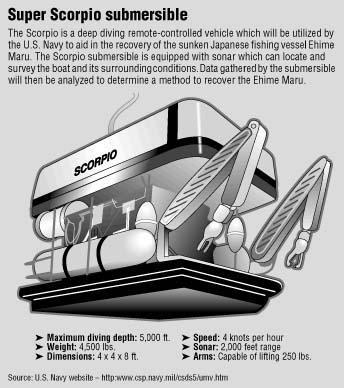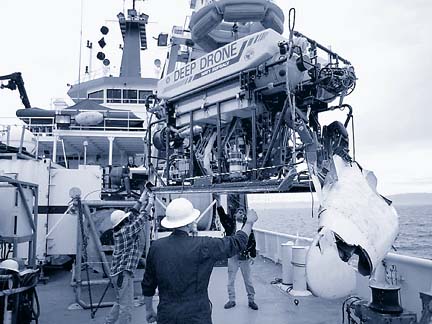Advertisement - Click to support our sponsors.


Navy calls in A team of Navy submarine rescue experts and two deep-sea remote probes may be used to help search for the Japanese fishing vessel accidentally sunk by a nuclear attack submarine.
deep sea probes
for search
A team of submarine rescue
experts also may be used
in the operations
Submarine investigation
By Gregg K. Kakesako
Star-BulletinThe first probe, Scorpio, and a crew of two dozen sailors commanded by Cmdr. Lee Hall arrived at Hickam Air Force Base this morning from Coronado, Calif.
A second, deeper diving unmanned probe also was to be dispatched by the Navy from the East Coast. However, there reportedly have been problems loading it.
Both probes will only be used to survey the area where the Ehime Maru sank Friday. Both unmanned probes will be operated from the commercial vessel C-Commando, normally berthed at the Pearl City Peninsula.

Relatives of the nine missing sailors have urged the Navy to salvage the ship. Prime Minister Yoshiro Mori also told U.S. Ambassador Thomas Foley on Sunday that rescuers should use "all available means" to raise the sunken vessel, according to a spokesman for Mori.The 190-foot fishing vessel is believed to be 1,866 feet below the surface, but it's not known whether it broke apart. It sank so quickly that damage caused when it was struck by the 360-foot nuclear submarine could not be seen. Also unknown is whether the ocean bottom is sandy or muddy.
Raising the 499-ton Japanese ship is considered to be a monumental task.
Lt. Christy Sheaff, Navy spokeswoman for the Navy's Deep Submergence Unit at Coronado, said the Scorpio can dive to 5,000 feet. The maximum diving depth of the other probe is 7,200 feet.
Also being deployed to Hawaii from Coronado is a side-scanning radar system to map the ocean bottom.
Sheaff said the Scorpio, one of two maintained by the Navy in Coronado, can only lift objects weighing less than 500 pounds with its two mechanical arms.
Sonar and several TV cameras are two of the Scorpio's primary tools.

The Scorpio was involved in mapping the debris field and finally raising small tail sections of Alaska Airlines Flight 261 off the coast of California Jan. 31, 2000.The tethered system also retrieved with its two mechanical arms the aircraft's "black boxes." Deep Submergence Unit personnel found the cockpit voice recorder and the flight data recorder in 700 feet of water.
A pilot and co-pilot remotely controlled the Scorpio, supported by Navy navigation personnel using Global Positioning System equipment.
Other personnel operated the 5,000-foot umbilical cord that connects the probe to the control station.
The Scorpio is owned by the Navy supervisor of diving and salvage while the other probe is managed by the Naval Sea Systems Command.
Two National Transportation Safety Board members will arrive tomorrow to join the investigation.
One member is a naval architect, the other is from the office of aviation safety and worked with the salvage equipment during the Alaska Airlines investigation.
The Boeing MD-80 was on a flight from Puerto Vallarta, Mexico, to San Francisco when it crashed 40 miles northeast of Los Angeles Jan. 31.
Coast Guard provided this outline of its response to the sinking of Ehime Maru: Timeline of rescue
1:55 p.m. Friday: Navy Command Submarine Pacific notifies Coast Guard of collision.
1:56 p.m.: Coast Guard HH-65 Dolphin helicopter diverted from whale sanctuary flight to accident scene.
1:58 p.m.: Coast Guard Station Honolulu is notified of accident.
2 p.m.: Coast Guard Joint Rescue Coordination Center receives electronic position indicating radio beacon alert from Ehime Maru.
2:01 p.m.: Joint Rescue Coordination Center issues urgent marine information broadcast.
2:05 p.m.: 24-foot rigid hull inflatable boat and 41-foot utility boat are under way.
2:27 p.m.: HH-65 helicopter arrives on scene, begins search for survivors not in life rafts.
2:31 p.m.: Rigid hull inflatable boat arrives on scene, begins checking each of 10 life rafts for survivors, counts survivors, gives triage, begins picking up survivors.
2:44 p.m.: Utility boat arrives on scene, begins rescuing survivors from life rafts.